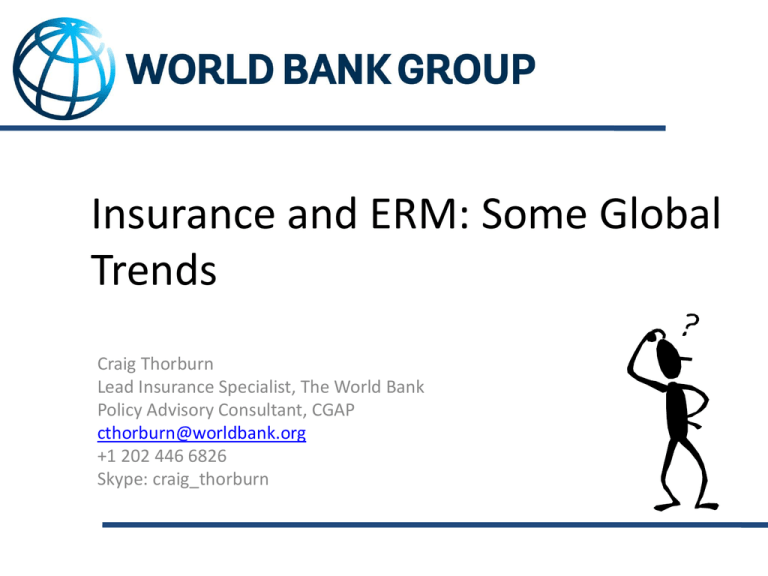Craig Thorburn Presentation
advertisement

Insurance and ERM: Some Global Trends Craig Thorburn Lead Insurance Specialist, The World Bank Policy Advisory Consultant, CGAP cthorburn@worldbank.org +1 202 446 6826 Skype: craig_thorburn • Several institutions and organizations do surveys. Two recent ones: – North Carolina State University (Compares a wide range of types of entity, focused on the USA) – Deloitte (A smaller group and only financial institutions only, but global) • Presenter experience from discussions with insurers and insurance supervisors. 2 My first question… Why do you have the amount of capital that you have? The answer will tell you how well your ERM is working.. 3 Not yet where we want to be • ERM increasingly a business necessity based on actual experience – “65% of enterprises, more larger entities or public companies, admit they were caught off guard by an operational surprise” – Only 25% of respondents consider they have a complete formal ERM in place (unchanged) – 52% indicate ERM is yet to be viewed as a strategic advantage • Boards and external stakeholders (through interest in greater disclosure) are pressing senior management to be more engaged. Close to half of respondents have internal ERM oriented risk committee at senior management level who meet at least quarterly. • Although only 32% of surveyed entities have a designated CRO, this is far more / most likely for financial services entities. 4 Adoption and Maturity of ERM: Percentage of Respondents Full Sample Largest Entities Public Cos Financial Services Not-forprofits No ERM process in place 24 7 7 13 26 Partial ERM in place addressing some but not all risk areas 30 39 37 33 30 Complete formal ERM in place 25 44 48 42 19 Maturity of ERM – Robust 4 11 9 9 2 - Mature 19 25 30 25 15 - Evolving 35 41 39 40 34 - Developing 23 15 14 20 25 - Very immature 19 8 8 6 24 5 Adoption and Maturity of ERM: Percentage of Respondents Full Sample Largest Entities Public Cos Financial Services Not-forprofits - Extensive 14 26 25 19 11 - Mostly 27 34 40 29 24 - Somewhat 27 26 23 27 33 Combined 68 86 88 75 68 Designated individual serving as CRO 32 49 50 56 22 - Reports to CEO 46 44 45 52 43 - Reports to Board / Board Committee 32 28 34 32 18 - Reports to CFO 13 18 13 10 216 Boards asking for increased senior management engagement is Factors mostly or extensively leading to increased senior executive focus on risk management activities: Percentage of Respondents Full Sample Largest Entities Public Cos Financial Services Not-forprofits - Regulatory demands 33 47 49 63 25 - Unanticipated risk events 32 45 44 35 30 - Emerging best practices 33 39 39 50 34 - Emerging corporate governance requirements 32 49 50 51 25 - Boards of director’s requests 31 51 48 31 26 7 Risk Inventories and Assessments: Percentage of Respondents Full Sample Largest Entities Public Cos Financial Services Not-forprofits 33 53 57 47 25 28 / 29 48 / 49 46 / 47 43 / 42 19 / 17 - Not at all 33 12 10 18 43 - Annually 34 39 36 38 36 - Semi-annually 10 12 14 10 9 - Quarterly 15 25 29 22 6 - Monthly or more frequently 8 12 11 12 6 Maintain enterprise wide risk inventories Guidelines to business line leaders on assessing risk (probability / impact) Frequency that inventories are updated 8 Particular regulatory directions • ORSA • Requirements for risk tolerance statements, risk management policies and processes… – ERM seen as a way to turn risk management obligations into core business value add (even if not yet fully in place) • Capital management policies, and risk based capital and supervision approaches. 9 Key themes … • Regulatory drivers • Business drivers – governance etc • Reactions to having had a bad experience • Just plain good ideas 10 Concluding comments 11









